Colombia's Colonial Jewels & the Coffee Triangle
with pre-trip to Bolivia: La Paz & Lake Titicaca
January 31 - February 19, 2019
Part One, Page One: Bolivia
Bolivia is a landlocked country located in western-central South America.
The capital is Sucre while the seat of government and financial center is located in La Paz.
The country's population, estimated at 11 million, is multiethnic, including Amerindians, Mestizos,
Europeans, Asians, and Africans. The racial and social segregation that arose from Spanish colonialism
has continued to the modern era. Spanish is the official and predominant language, although 36 indigenous
languages
also have official status, of which the most commonly spoken are Guarani, Aymara,
and Quechua languages.
Before Spanish colonization, the Andean region of Bolivia was part of the Inca
Empire,
while the northern and eastern lowlands were inhabited by independent tribes.
Spain built its empire in large part upon the silver that was extracted from Bolivia's mines.
After the first call for independence in 1809, 16 years of war followed before the establishment of the Republic,
named for Simon Bolivar. Over the course of the 19th and early 20th century Bolivia
lost control of several peripheral territories to neighboring countries including the seizure of its coastline by
Chile in 1879 (still a sensitive issue). Bolivia remained relatively politically stable until 1971,
when Hugo Banzer led a coup which replaced the socialist government of Juan Jose Torres
with a military dictatorship headed by Banzer. Banzer's regime cracked down on leftist and socialist opposition
and other forms of dissent, resulting in the torture and deaths of a number of Bolivian citizens. Banzer was
ousted in 1978
and later returned as the democratically elected president of Bolivia from 1997 to 2001.
Evo Morales won the 2005 presidential election with 53.7% of the votes, an absolute majority
unusual in Bolivian elections. He fulfilled a campaign promise in 2006 by announcing his
intention to nationalize Bolivian hydrocarbon assets. The nationalization of energy and mining
interests was applauded by the poor, but has soured relations with foreign investors
and some foreign governments. Morales was re-elected in 2014 with a new election set for
2020. The export of raw materials remains the nation's bread and butter. With the world's
largest lithium deposits, plenty of natural gas and minerals, Bolivia could continue to
see good economic progress. The stumbling blocks could include climate change
and the reluctance of some foreign companies to invest money and expertise in a
country with a growing track record of nationalizations. The conservative province
of Santa Cruz is Morales' most vocal opponent, requesting more autonomy
and occasionally threatening secession.
The country has a poverty level of
about 40% down from 70% in the late 90s. The country has been occupied
for over 2,500 years, when the Aymara arrived. Present day Aymara associate
themselves with the ancient civilization of the Tiwanaku culture in western Bolivia.

View of part of La Paz from my hotel room.
La Paz is set in a canyon created by the Choqueyapu River.
It is located in a bowl-like depression surrounded by high
mountains of the Andean Plateau. The hillsides are
subject to frequent landslides.

View from the bar on top floor of Atix Hotel
La Paz was founded in 1548 by a Spanish conquistador
at the site of an Inca settlement, as a connecting point between
commercial routes and was under Spanish colonial
rule until Bolivia gained independence.

Woman in traditional dress in La Paz - brightly colored multi-
layered skirts and bowler hats. Younger people tend not
to wear the traditional dress and feel they have better
employment opportunities if they dress like the modern world.
La Paz elevation is almost 12,000 ft, the highest capital city
in the world. The airport is the highest International airport
in the world at 13,325 feet (Airport is in the neighboring
El Alto community).
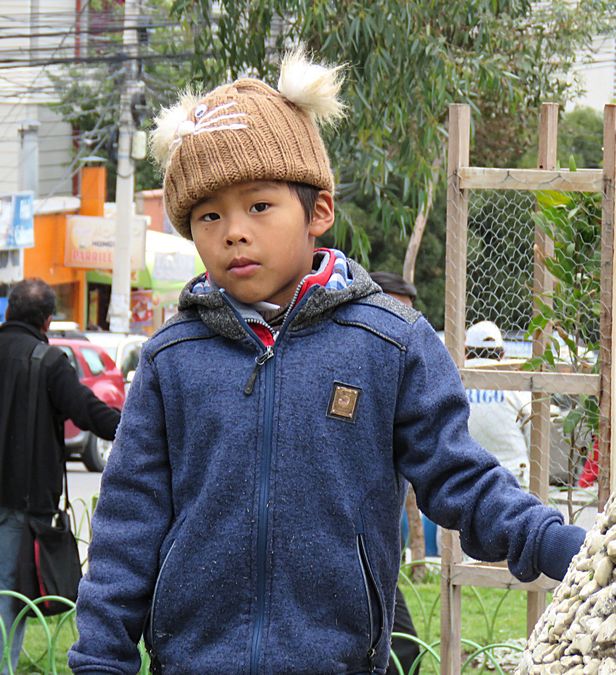
Boy playing in green area next to a church

Cute art work of llamas near the reception area of the hotel.

Dog owners in La Pax often clothe their dogs to keep them
warm in the cool, high altitude climate. We also saw many
stray
dogs, who didn't bother us.

View from Killi Killi, a mirador (scenic viewpoint) that offers views
of the city and the Andean Plateau and mountains. The airport
is on the distant plateau.

Another view from Killi Killi

School kids on an outing to the viewpoint.
Education in Bolivia, as in many other areas of Bolivian life,
has a divide between Bolivia's rural and urban areas. Rural illiteracy levels remain high,
even as the rest of the country becomes increasingly literate.
Bolivia devotes 23% of its annual budget to educational expenditures, a higher percentage
than in most other South American countries, but from a smaller national budget.
School time is split into 2 shifts (morning and afternoon)
so everything is compressed and there is little time for things
that make education pleasurable. State schools
are underfunded and in poor repair too. The first 6 years of
primary school are free and theoretically compulsory,
although in practice approximately 20% of children receive no benefit.
The four years of secondary education are non-compulsory
and less than a quarter of young adults attend.
Those that do so, mainly go to private schools (the wealthier familiies).
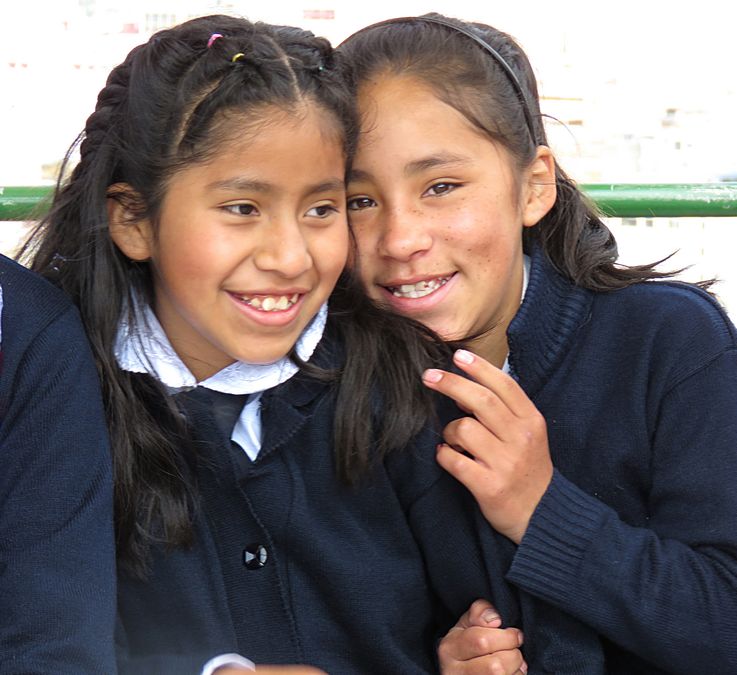
The school year was just starting in February when we were there.

Woman in traditional dress and using modern technology

Many of the women one sees in traditional dress are
street vendors. I used my zoom lens for most photos
of women in traditional dress, since many still believe
that taking their photo means taking part of their soul.
Otherwise, I asked permission.
The school kids shown
above liked having their photos taken, and I
showed them the photos.

The Cathedral and Murillo Square in La Paz.
The Square or Plaza Murillo is the central plaza of the city of La Paz
and the open space most connected to the political life of Bolivia. Prominent
buildings on the plaza include the Presidential Palace, National Congress of
Bolivia, and the Cathedral of La Paz.

People like to go to the plazas or
squares to sit, relax, feed the pigeons, etc.

The Presidential Palace on the left and the Cathedral
on the right from Murillo Square. The President
of Bolivia uses a helicopter to land on top of the modern
building
behind the Palace, called the Burned Palace for
the numerous times it has burned.
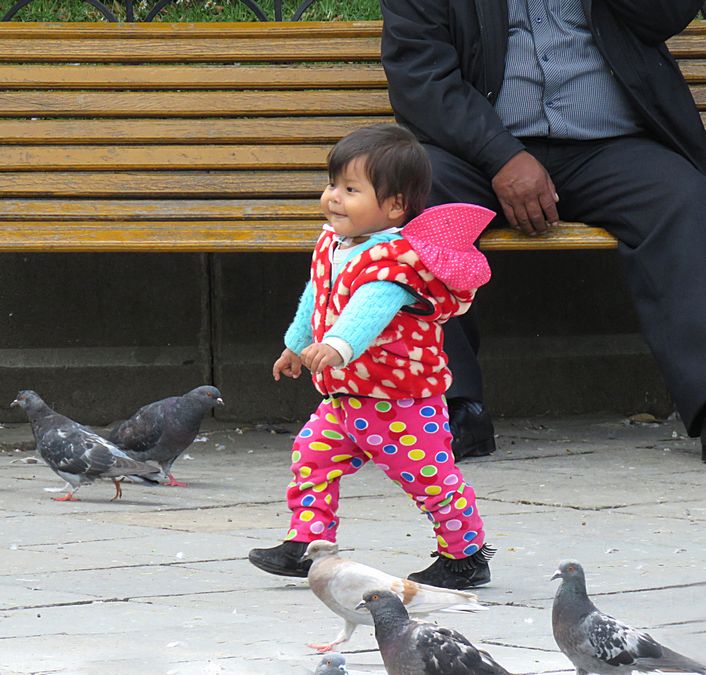
Child enjoying the pigeons in Murillo Square. Pedro Domingo Murillo
played a key role in the fight for Bolivian independence, and his statue is in the square.

More people in the square
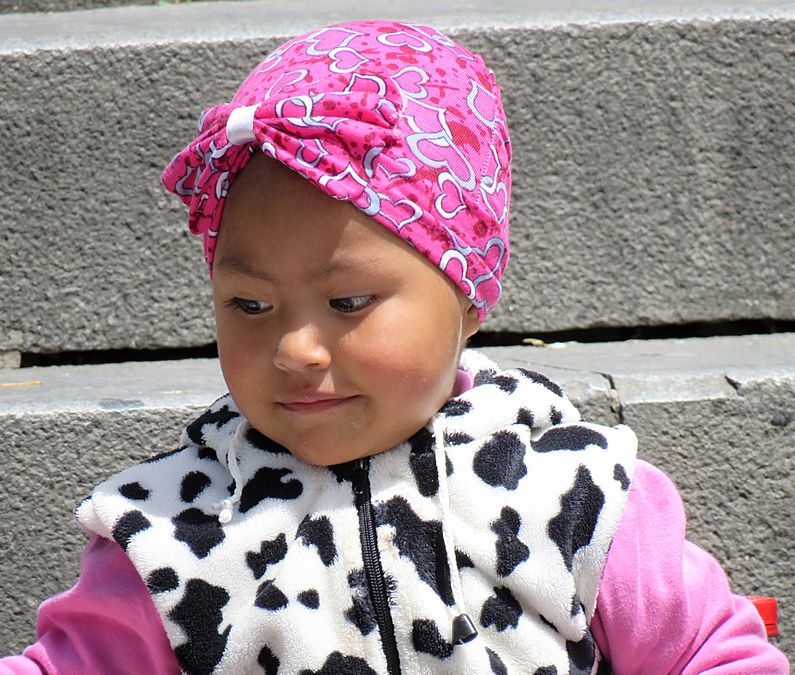
Child who was with her mother looking at the pigeons in the square.

La Paz is home to the longest, highest and most modern urban
cable car network in the world, serving the metro area with 8
lines with more lines coming.
The Red, Yellow, and Purple lines connect the neighboring
cities of La Paz and El Alto, which are separated by a steep slope
about 1,300 ft tall, and which were previously only connected
by winding, congested roads. We took cable cars twice with our
tour leader Jimena to
expedite our travel.

Street art in La Paz

An elderly woman visiting La Paz Cemetery

La Paz Cemetery
Bodies are first buried or are placed in a crypt. Then, within 10 years, they are
disinterred and cremated. After cremation, families purchase or rent
glass-fronted spaces in the cemetery walls for the ashes.

They affix plaques and mementos of the deceased, and
place flowers behind the glass door. This deceased
clearly was a young child.

Woman wearing traditional bowler hat of the indigenous people
at the cemetery. The hat is worn on the very top of the head
with no attachment to hold it on.
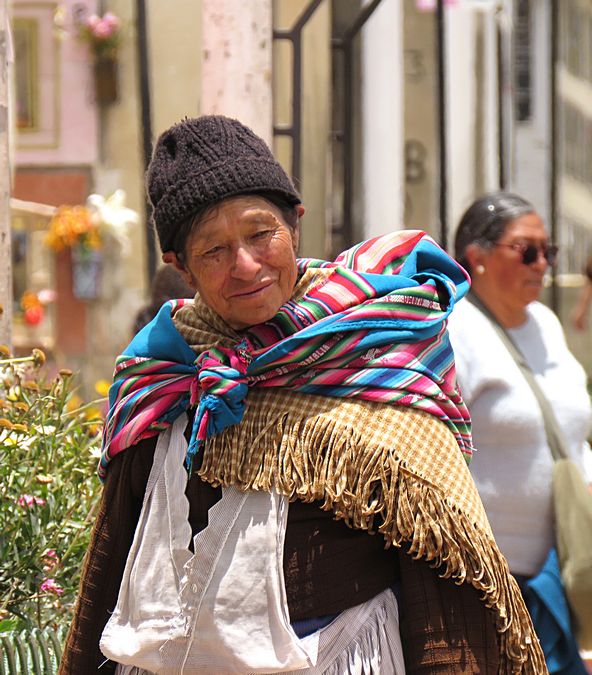
A woman walking through a local market area in La Paz

Pat looking silly in a bowler hat in the Witches' Market area of
La Paz, where indigenous people sell plants, potions, and talismans
used in ancient Aymara healing rituals, and witch doctors
offer their fortune-telling services. The Aymara lived in the region for many
centuries before becoming a subject people of the Inca in the late 15th or
early 16th century, and later of the Spanish in the 16th century. Aymara
language is still spoken in Bolivia in addition to Spanish.

The Basilica of San Francisco in La Paz, located in the center of
the city, in the square that bears its name, "Plaza San Francisco."
Near the Witches' Market area.
The Plaza is a frequent location
for political gatherings and protests.
Link to Part One, Page Two - Valley of the Moon and Road to Copacabana
Pat's Home Page